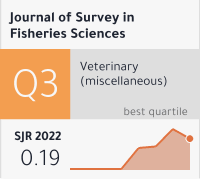Backcross breeding between TGGG hybrid grouper (Epinephelus fuscoguttatus E. lanceolatus) and giant grouper (E. lanceolatus)
DOI:
https://doi.org/10.17762/sfs.v7i2.119Keywords:
Backcross breeding, Epinephelus lanceolatus, Epinephelus fuscoguttatusAbstract
This paper reports on the first successful backcross breeding between TGGG hybrid grouper and GG in captivity. To establish a seed production technique for this new backcross grouper, eggs and larval development were observed. Three successful spawning was observed in November 2018, September 2019 and November 2019. The eggs were collected using stripping methods and the sperms were collected using sperms collector. About 1.2 to 1.3 litres of eggs were collected in each spawning. Eggs and larval development of backcross TGGG hybrid and GG were almost similar to its parental species and other Epinephelus species. Fertilized eggs were measured 0.860 to 0.915 mm in diameter, with oil globule 0.190 to 0.214 mm in diameter. Fertilization and hatching rate were in between 80 to 90 %. Newly hatched larvae range from 1.64 to 1.99 mm and commenced feeding at 60 d AH. Larval dorsal and pelvic spines started to develop from 9 d AH and fins were formed on 21 d AH. By the age of 30 d AH, the fish entered juvenile stage. At 60 d AH, the fry’s body shape and colour resembled those of the adult. After more than 300 d AH, the fish reached 1 kg in weight. The backcross between female TGGG and male GG is expected to perform even better growth and survival rate than TGGG because the backcross carries more genetic material from the GG, which would be ideal for mass production in the aquaculture industry.










